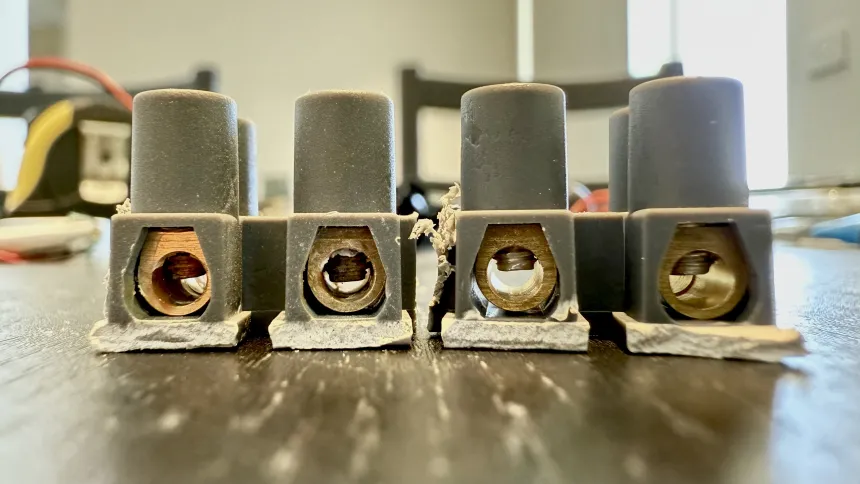When I first prototyped KhawTECH’s AWD tube, I wanted something dirt-cheap and simple to help farmers monitor water levels in their paddies. I used a PVC tube, an ESP32 with LoRa for long-range data transmission, a small solar panel, and a battery to keep it running. For sensing water levels, I went with three pairs of screw terminals at different heights, wired to the ESP32 with Ethernet cable. The idea was that water would close the circuit between the terminals, telling the level (low, medium, or high).
It worked… for a bit. But after just a couple of days in the muddy, salty water of our paddies in Kut Chum, those screw terminals started to rust. I’ve got a photo of one lightly rusted terminal after a short stint in the field, and let me tell you, it wasn’t pretty. Corrosion means unreliable readings in the long term, and I knew small farmers won’t be very inclined to keep replacing or cleaning sensors every now and then. I needed a better solution, one that could last in Thailand’s harsh paddy conditions without breaking all the time.

Going Capacitive with Anodized Wires
After some tinkering (and lotsa coffee), I decided to ditch the conductive screw terminals for a capacitive sensing approach. Now, I’m using two 2 mm anodized aluminum wires running vertically inside the PVC tube, spaced 1 cm apart with zip ties every 10 cm. These wires don’t touch the water directly (as the anodized layer makes them non-conductive), so no more rust! Instead, they sense the water level by detecting changes in capacitance as the water rises, giving me continuous readings (like 5.7 cm) instead of just discrete levels.
This upgrade is a big deal for a few reasons:
- No More Rust: The anodized wires are corrosion-free, perfect for the salty, muddy water in Yasothon paddies. They’ve been holding up beautifully in testing!
- Real-Time Data: I can now measure precise water level, which means the water pump stops just when it should, saving water and energy.
- Still Cheap: Each complete AWD tube still costs around $10-15, keeping it affordable for small farmers. The wires were just $2.50 for 100 m on Lazada, and the zip ties and spacers added around $1 for 100 pieces.
Here’s a photo of the new setup inside the PVC tube, with the wires neatly spaced and ready to go.

Why This Matters
At KhawTECH, my mission is to help small farmholders modernize without breaking the bank. Rice farming in rural Thailand is tough, especially with unpredictable water from the sources. AWD helps save water increasing yields at the same time, but only if the tech is reliable and cheap. The old design was a start, but the rust was a dealbreaker. This upgraded AWD tube, with its rust-free capacitive sensor, is a big step toward a polished, final product that farmers can actually rely on.
AgTech lets farmers monitor paddy water levels remotely, cutting down on return trips under Thailand’s heavy sun and saving time and energy.
The tube still uses the same ESP32 board with LoRa to send data 1.43 km to a gateway. It’s all housed in an IP66 enclosure with bamboo shading to beat Yasothon’s heat. For local farmers, this means a “set it and forget it” solution that doesn’t need constant fixing. They do just what they need to focus on growing rice, not troubleshooting tech.
What’s Next?
I’m testing these upgraded tubes across a small 2,500 m² plot in Kut Chum, and so far, the results are awesome. The continuous water level data is helping fine-tune irrigation, and farmers are loving the fact that they don’t need to check the water levels in person, saving them time and effort. Next, I’m working on bundling these AWD tubes into affordable smart farming kits for young farmers to experiment with.